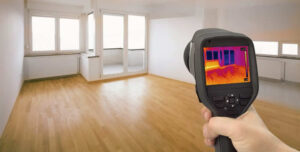What're your ideas concerning Detecting hidden plumbing leaks?

Early detection of dripping water lines can minimize a potential calamity. Some tiny water leakages may not be noticeable.
1. Take A Look At the Water Meter
Every house has a water meter. Checking it is a surefire way that assists you find leakages. For starters, shut off all the water sources. Make sure no person will flush, utilize the faucet, shower, run the cleaning equipment or dishwasher. From there, go to the meter and watch if it will change. Since no one is using it, there ought to be no movements. That shows a fast-moving leakage if it relocates. Similarly, if you find no changes, wait an hour or more and also check back once more. This indicates you may have a sluggish leak that can also be underground.
2. Inspect Water Usage
Analyze your water costs as well as track your water usage. As the one paying it, you ought to see if there are any kind of inconsistencies. If you identify sudden changes, in spite of your consumption coinciding, it implies that you have leakages in your plumbing system. Keep in mind, your water bill should drop under the very same variety monthly. A sudden spike in your expense indicates a fast-moving leak.
A steady increase every month, also with the same routines, reveals you have a slow-moving leakage that's also slowly intensifying. Call a plumber to completely check your residential property, particularly if you feel a cozy area on your floor with piping below.
3. Do a Food Coloring Examination
When it comes to water intake, 30% comes from toilets. If the shade somehow infiltrates your dish during that time without flushing, there's a leak in between the tank and also bowl.
4. Asses Outside Lines
Do not forget to inspect your outdoor water lines as well. Needs to water seep out of the connection, you have a loosened rubber gasket. One little leak can lose loads of water as well as increase your water bill.
5. Assess the circumstance and check
House owners should make it a behavior to inspect under the sink counters and also also inside cupboards for any bad odor or mold development. These 2 red flags suggest a leak so timely focus is called for. Doing routine examinations, even bi-annually, can save you from a major trouble.
More significantly, if you recognize your home is already old, keep a watchful eye on your heaters, tubes, pipes etc. Look for discolorations and weakening as a lot of home appliances and pipelines have a life expectancy. They will also normally weaken due to tear and use. Do not wait for it to escalate if you suspect leaking water lines in your plumbing system. Call a specialist plumber as soon as possible so you don't end up with a terrible mess in your home.
Early discovery of dripping water lines can alleviate a prospective disaster. Some small water leaks may not be noticeable. Inspecting it is a surefire way that assists you find leakages. One little leakage can throw away lots of water as well as spike your water costs.
If you presume leaking water lines in your plumbing system, don't wait for it to intensify.
WARNING SIGNS OF WATER LEAKAGE BEHIND THE WALL
PERSISTENT MUSTY ODORS
As water slowly drips from a leaky pipe inside the wall, flooring and sheetrock stay damp and develop an odor similar to wet cardboard. It generates a musty smell that can help you find hidden leaks.
MOLD IN UNUSUAL AREAS
Mold usually grows in wet areas like kitchens, baths and laundry rooms. If you spot the stuff on walls or baseboards in other rooms of the house, it’s a good indicator of undetected water leaks.
STAINS THAT GROW
When mold thrives around a leaky pipe, it sometimes takes hold on the inside surface of the affected wall. A growing stain on otherwise clean sheetrock is often your sign of a hidden plumbing problem.
PEELING OR BUBBLING WALLPAPER / PAINT
This clue is easy to miss in rooms that don’t get much use. When you see wallpaper separating along seams or paint bubbling or flaking off the wall, blame sheetrock that stays wet because of an undetected leak.
BUCKLED CEILINGS AND STAINED FLOORS
If ceilings or floors in bathrooms, kitchens or laundry areas develop structural problems, don’t rule out constant damp inside the walls. Wet sheetrock can affect adjacent framing, flooring and ceilings.
https://www.servicemasterbyzaba.com/blog/how-to-detect-water-leakage-in-walls/
.jpg)
I'm certainly very intrigued by Hacks to detect leaks and I am praying you appreciated the entry. Are you aware of somebody else who is interested in the niche? Take a moment to promote it. Thank you for taking the time to read it.
Visit Homepage